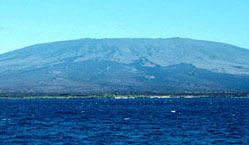|
Hot Topics: Introduction to the Galápagos Islands By Mark Kurz and Karen HarppOne of the most common questions that scientists and nature lovers ask when they see an interesting rock is: how old is it?  Cerro Azul vocano on Isabela Island. But sometimes, rock layers can get bent, twisted and folded, and even turned upside down. “Older on the bottom and younger on the top” doesn’t work anymore. In 1896, Antoine Becquerel discovered radioactivity. In the early 1900’s, scientists found a way to determine the real ages of rocks and minerals using radioactivity. Some of the elements that make up minerals in rocks are radioactive and breakdown into other elements. This is known as radioactive decay. Each radioactive “parent” element decays to a stable “daughter” element at a certain rate. Once this rate is known, scientists can use the production of the daughter element as a geologic clock. This is a branch of geology called “geochronology.” Think about an hourglass. Imagine the sand in the top is a group of parent elements. The grains move through the narrow part of the hourglass at a constant rate. When they fall into the bottom, they have changed into daughter elements. If you know how quickly the sand moves through the glass neck, you can estimate how much time has passed since someone started the hourglass simply by looking at how big the pile of sand is at the bottom. One of the most common methods to date volcanic rocks uses potassium (radioactive parent) and argon (stable daughter). Potassium is an element found in many minerals and rocks, and it normally has an atomic mass of 39. But there is a rare form of potassium that has an atomic number of 40 because it has an extra neutron. Forms of an element that have the same chemical properties but different masses are called “isotopes.” It takes 1.25 billion years for half of the original potassium-40 isotope to decay to argon—this is called the “half life.” When a volcanic rock is erupted at the Earth’s surface, the clock starts ticking. As time passes, the potassium-40 in the rock decays to argon-40. Scientists can measure the argon-40 produced after eruption, and the amount of potassium-40 responsible for the decay, and then figure out when the lava erupted. Rocks from around the world have been dated using this method, including the older volcanoes in the Galápagos Islands. Scientists have also dated rocks from central Africa that contain fossil evidence of the first human species. But some volcanic rocks are only hundreds or thousands of years old and they don’t contain much potassium, so the potassium-argon method doesn’t work for them. So we need a different method for dating young volcanic rocks. We make use of cosmic rays that come from deep space and are constantly hitting the Earth. When they hit, they produce tiny amounts of different elements in rock surfaces by nuclear reactions. One such element is helium-3. Just like natural radioactivity, if we know the rate of production of helium-3 and we can measure how much is produced by the cosmic rays, we can calculate how long the rock has been exposed on the surface of the Earth. In our laboratory at Woods Hole Oceanographic Institution, we use an instrument called a mass spectrometer to measure tiny amounts of helium-3 to determine the ages of Galápagos lava flows. We have found that the entire surface of Fernandina volcano, outside of the summit caldera, is less than 4000 years old—younger than most geologists thought. Yet other Galápagos lava flows are as young as a few hundred years. Knowing ages of lava flows tells us how often a volcano erupts. This can be important in assessing whether the volcano poses any hazard to surrounding areas.
|
|
© 2010 Dive and Discover™. Dive and Discover™ is a registered trademark of Woods Hole Oceanographic Institution
|
|

